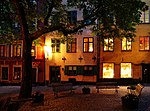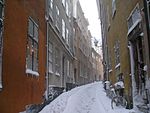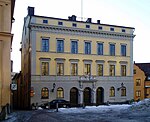Köpmantorget
Squares in StockholmStockholm County geography stubs

Köpmantorget (Swedish: "Merchant's Square") is a small public square in Gamla stan, the old town in central Stockholm, Sweden. It is located between the street Köpmangatan to the west and between two slopes collectively named Köpmanbrinken, both of which lead down to the street Österlånggatan. On its western side, two streets lead north and south: Bollhusgränd and Baggensgatan respectively.
Excerpt from the Wikipedia article Köpmantorget (License: CC BY-SA 3.0, Authors, Images).Köpmantorget
Köpmantorget, Stockholm Gamla stan (Södermalms stadsdelsområde)
Geographical coordinates (GPS) Address External links Nearby Places Show on map
Geographical coordinates (GPS)
| Latitude | Longitude |
|---|---|
| N 59.325111111111 ° | E 18.073555555556 ° |
Address
Köpmantorget
Köpmantorget
Stockholm, Gamla stan (Södermalms stadsdelsområde)
Sweden
Open on Google Maps









